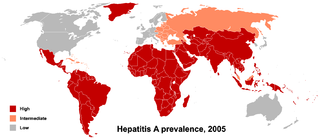Related Research Articles

Theoretical ecology is the scientific discipline devoted to the study of ecological systems using theoretical methods such as simple conceptual models, mathematical models, computational simulations, and advanced data analysis. Effective models improve understanding of the natural world by revealing how the dynamics of species populations are often based on fundamental biological conditions and processes. Further, the field aims to unify a diverse range of empirical observations by assuming that common, mechanistic processes generate observable phenomena across species and ecological environments. Based on biologically realistic assumptions, theoretical ecologists are able to uncover novel, non-intuitive insights about natural processes. Theoretical results are often verified by empirical and observational studies, revealing the power of theoretical methods in both predicting and understanding the noisy, diverse biological world.

An epidemic is the rapid spread of disease to a large number of hosts in a given population within a short period of time. For example, in meningococcal infections, an attack rate in excess of 15 cases per 100,000 people for two consecutive weeks is considered an epidemic.

Human ecology is an interdisciplinary and transdisciplinary study of the relationship between humans and their natural, social, and built environments. The philosophy and study of human ecology has a diffuse history with advancements in ecology, geography, sociology, psychology, anthropology, zoology, epidemiology, public health, and home economics, among others.

Landscape ecology is the science of studying and improving relationships between ecological processes in the environment and particular ecosystems. This is done within a variety of landscape scales, development spatial patterns, and organizational levels of research and policy. Landscape ecology can be described as the science of "landscape diversity" as the synergetic result of biodiversity and geodiversity.

Urban ecology is the scientific study of the relation of living organisms with each other and their surroundings in an urban environment. An urban environment refers to environments dominated by high-density residential and commercial buildings, paved surfaces, and other urban-related factors that create a unique landscape. The goal of urban ecology is to achieve a balance between human culture and the natural environment.
Ecoinformatics, or ecological informatics, is the science of information in ecology and environmental science. It integrates environmental and information sciences to define entities and natural processes with language common to both humans and computers. However, this is a rapidly developing area in ecology and there are alternative perspectives on what constitutes ecoinformatics.

Health geography is the application of geographical information, perspectives, and methods to the study of health, disease, and health care. Medical geography, a sub-discipline of, or sister field of health geography, focuses on understanding spatial patterns of health and disease in relation to the natural and social environment. Conventionally, there are two primary areas of research within medical geography: the first deals with the spatial distribution and determinants of morbidity and mortality, while the second deals with health planning, help-seeking behavior, and the provision of health services.

Systems ecology is an interdisciplinary field of ecology, a subset of Earth system science, that takes a holistic approach to the study of ecological systems, especially ecosystems. Systems ecology can be seen as an application of general systems theory to ecology. Central to the systems ecology approach is the idea that an ecosystem is a complex system exhibiting emergent properties. Systems ecology focuses on interactions and transactions within and between biological and ecological systems, and is especially concerned with the way the functioning of ecosystems can be influenced by human interventions. It uses and extends concepts from thermodynamics and develops other macroscopic descriptions of complex systems.
The following outline is provided as an overview of and topical guide to ecology:

An ecosystem model is an abstract, usually mathematical, representation of an ecological system, which is studied to better understand the real system.
Pedodiversity is the variation of soil properties within an area. Pedodiversity studies were first started by analyzing soil series–area relationships. According to Guo et al. (2003) the term pedodiversity was developed by McBratney (1992) who discussed landscape preservation strategies based on pedodiversity. Recently, examinations of pedodiversity using indices commonly used to characterize bio-diversity have been made. Ibáñez et al. (1995) first introduced ecological diversity indices as measures of pedodiversity. They include species richness, relative species abundance, and Shannon index. Richness is the number of different soil types, which is the number of soil classes at particular level in a taxonomic system. Abundance is defined as the distribution of the number of soil individuals.

Yevgeny Nikanorovich Pavlovsky was a Soviet zoologist, entomologist, academician of the Academy of Sciences of the Soviet Union (1939), the Academy of Medical Sciences of the USSR (1944), honorary member of the Tajik Academy of Sciences (1951), and a lieutenant general of the Red Army Medical Service in World War II.
Sanitary epidemiological reconnaissance, synonym epidemiological reconnaissance is a literal name of a concept and routine of finding out disease potential on a territory of arrival of major contingent. Russian: санитарно-эпидемиологическая разведка, син. эпидемиологическая разведка. This is a kind of medical reconnaissance, process of information gathering on possible infectious diseases' origin-sources, the ways and factors of the infection transfer and determining all conditions that could have promoted the spread of infestation among army service personnel. In 1939 Academician E.N.Pavlovsky announced his "doctrine of nidality", so called by Soviet biologists. People can acquire zoonoses and insect-borne diseases when they occupy at certain times of the year natural habitat of a certain pathogen. The WHO Expert Committee on Zoonoses listed over 100 such diseases. About natural focality of the diseases is known elsewhere.
Environmental risk transition is the process by which traditional communities with associated environmental health issues become more economically developed and experience new health issues. In traditional or economically undeveloped regions, humans often suffer and die from infectious diseases or of malnutrition due to poor food, water, and air quality. As economic development occurs, these environmental issues are reduced or solved, and others begin to arise. There is a shift in the character of these environmental changes, and as a result, a shift in causes of death and disease.

Landscape genetics is the scientific discipline that combines population genetics and landscape ecology. It broadly encompasses any study that analyses plant or animal population genetic data in conjunction with data on the landscape features and matrix quality where the sampled population lives. This allows for the analysis of microevolutionary processes affecting the species in light of landscape spatial patterns, providing a more realistic view of how populations interact with their environments. Landscape genetics attempts to determine which landscape features are barriers to dispersal and gene flow, how human-induced landscape changes affect the evolution of populations, the source-sink dynamics of a given population, and how diseases or invasive species spread across landscapes.
Disease ecology is a sub-discipline of ecology concerned with the mechanisms, patterns, and effects of host-pathogen interactions, particularly those of infectious diseases. For example, it examines how parasites spread through and influence wildlife populations and communities. By studying the flow of diseases within the natural environment, scientists seek to better understand how changes within our environment can shape how pathogens, and other diseases, travel. Therefore, diseases ecology seeks to understand the links between ecological interactions and disease evolution. New emerging and re-emerging infectious diseases are increasing at unprecedented rates which can have lasting impacts on public health, ecosystem health, and biodiversity.

Global climate change has increased the occurrence of some infectious diseases. Infectious diseases whose transmission is impacted by climate change include, for example, vector-borne diseases like dengue fever, malaria, tick-borne diseases, leishmaniasis, zika fever, chikungunya and Ebola. One mechanism contributing to increased disease transmission is that climate change is altering the geographic range and seasonality of the insects that can carry the diseases. Scientists stated a clear observation in 2022: "The occurrence of climate-related food-borne and waterborne diseases has increased ."

Anopheles atroparvus is a European species of mosquito, which was first identified in 1927. It is one of the most abundant palearctic Anopheles species belonging to the family Culicidae, commonly called mosquitoes. Although research interest in A. atroparvus has been low in the past several decades, recent concern for an increase in vector-borne disease has encouraged new research into this species.

A. Alonso Aguirre is an American veterinarian, wildlife biologist, academic and researcher. He is Professor and Chair of the Department of Environmental Science and Policy, College of Science, and he also chairs the university Institutional Animal Care and Use Committee (IACUC) at George Mason University.

George Macdonald was a British physician who was Professor of Tropical Hygiene at the London School of Hygiene & Tropical Medicine. His research concentrated primarily on malaria, its epidemiology and control. He was the author of many papers on the mathematical analysis of transmission of tropical infections and the author of The Epidemiology and Control of Malaria, published in 1957.
References
- ↑ Kitron, U. "Landscape Ecology and Epidemiology of Vector-Borne Diseases: Tools for Spatial Analysis." Journal of Medical Entomology. 1998(35):435-445.
- ↑ Pavlovsky, E.N. Natural Nidality of Transmissible Diseases, With Special Reference to the Landscape Epidemiology of Zooanthroponse. Urbana, Ill.: University of Illinois Press, 1966.
- ↑ Galuzo, I.G. "Landscape Epidemiology (epizootiology)." Advances in Veterinary Science & Comparative Medicine. 1975(19):73-96.
- ↑ Chaves, L. S. M.; Conn, J. E.; López, R. V. M.; Sallum, M. A. M. (2018). "Abundance of impacted forest patches less than 5 km² is a key driver of the incidence of malaria in Amazonian Brazil." Scientific reports. 8(1), 7077. https://doi.org/10.1038/s41598-018-25344-5.
- ↑ Brownstein, J.S.; Rosen, H.; Purdy, D.; Miller, J.; Merlino, M.; Mostashari, F.; Fish, D. "Spatial Analysis of West Nile Virus: Rapid Risk Assessment of an Introduced Vector-Borne Zoonosis." Vector Borne and Zoonotic Diseases. 2(3):157-164.